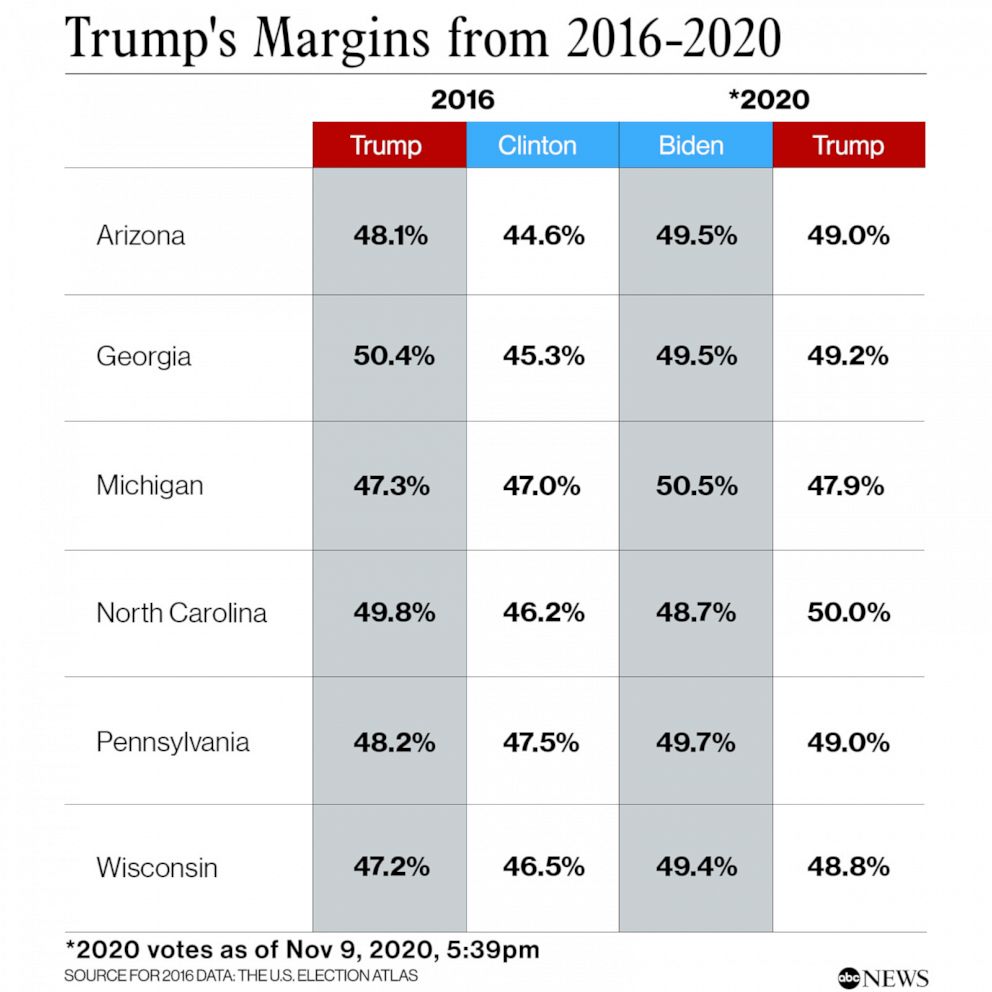A road to defeat for Trump: How the 2020 election is different from 2016
Biden is currently leading Trump by nearly 5 million votes nationally.
For President Donald Trump, 2020 is not shaping up to be like 2016.
Trump is set to close out the year as a lame-duck president, with his rival, Joe Biden, assuming the title of president-elect after being projected the winner of a tumultuous campaign waged in the middle of dual crises: the coronavirus pandemic and the economic fallout.
Biden has eclipsed the necessary 270 electoral votes and is currently leading Trump by nearly 5 million votes nationally, with votes still left to be counted. He's also ahead by thousands of votes in nearly all of the crucial battlegrounds. Yet Trump still refuses to concede, charging -- without evidence -- that there has been extensive fraud in some of this year's closest contests where he is behind.
"I just think it's an embarrassment, quite frankly," Biden told reporters Tuesday of Trump's unwillingness to concede. "I understand the sense of loss. I get that, but I think the majority of the people who voted for the president ... I think they understand that we have to come together. I think they're ready to unite."
Unlike four years ago, when Trump ascended to the presidency after a string of unexpected victories across the upper Midwest, Biden stitched together a winning coalition that withstood Trump's loyal army of supporters.

Biden's success is no more apparent than in Michigan, where he currently holds a healthy lead of almost 150,000 votes, which is nearly 15 times more than Trump's narrow margin of 10,704 in 2016.
In Pennsylvania, Trump trails Biden by at least 47,000 votes, a slightly wider gap than Trump's own margin of 44,000 votes four years ago over Hillary Clinton in the Keystone State.
The split between Biden and Trump is the smallest in Wisconsin of the three Rust Belt States, with roughly 20,000 votes separating the two men, which is just under the 23,000 votes that allowed Trump to topple Clinton in the state.
While Biden's advantage in Wisconsin remains within the recount margin, which Trump would have to request, his margins in both Michigan and Pennsylvania is outside the window for an automatic recount in those two states.
Even as Trump defiantly spurns the election results, he's also ignoring how much slimmer his margin of victory was in 2016.

The presidential election four years ago largely tilted in Trump's favor by just 80,000 votes across Michigan, Pennsylvania and Wisconsin. Biden's edge currently stands at more than 200,000, with votes still outstanding, in those same three states.
Only four states have yet to be projected by ABC News: Georgia, Arizona, North Carolina and Alaska. Trump won all four in 2016.
Biden is ahead by at least 12,000 votes in both Georgia and Arizona, with the count continuing. He could become the first Democratic presidential candidate since Bill Clinton to win these states.
A recount is anticipated in Georgia, with the Trump campaign is already saying it will request one. Biden currently sits outside the automatic recount margin in Arizona.
Both states have swung significantly toward Democrats since 2016. Even in states where Trump is leading, such as North Carolina, Biden has cut into the president's margin by nearly half. In Alaska, a state Trump won by 15 points four years ago, he is currently ahead by a comfortable 28-point margin. But that could tighten when absentee ballot counting begins on Tuesday.
Trump's legal team is pursuing challenges in at least five states, some of which have already failed. His campaign has yet to produce any evidence of widespread fraud that could reverse the election's outcome.
One day after the 2016 election, Clinton called Trump to acknowledge she lost.
But this is not 2016.